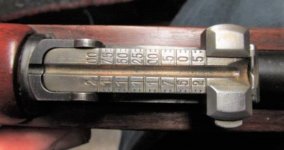luftmacher
Senior Member
The photos below are from a recent on-line auction of a very interesting BSW training rifle. First, note that there is no model designation on the receiver, although this appears to be the W625 action. The stock has a take-down disc in it, and features DSM bands on the fore end.
The serial number comes from mid-1936. In early 1936, Dr. Hoffmann advised the factory administration at BSW to pull the plug on DSM production, for fear they might end up with rifles which could not be sold. Consumer complaints about the DSM had caused most of the contract DSM makers to cease production, and they were by then obtaining military contracts which were more profitable, anyway. BSW's DSM production was in a hiatus for some months, and did not resume until a final push to clear DSM parts from inventory (beginning about the serial number 177xxx range) later on (about May 1937).
This was a very rare example, and someone got it for a good price.
Steve





The serial number comes from mid-1936. In early 1936, Dr. Hoffmann advised the factory administration at BSW to pull the plug on DSM production, for fear they might end up with rifles which could not be sold. Consumer complaints about the DSM had caused most of the contract DSM makers to cease production, and they were by then obtaining military contracts which were more profitable, anyway. BSW's DSM production was in a hiatus for some months, and did not resume until a final push to clear DSM parts from inventory (beginning about the serial number 177xxx range) later on (about May 1937).
This was a very rare example, and someone got it for a good price.
Steve





Last edited:




